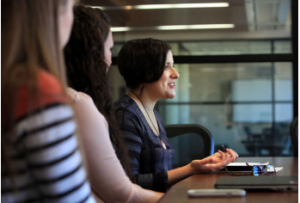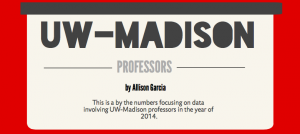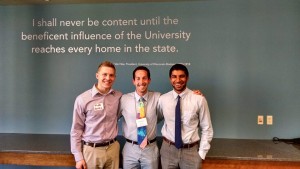by Allison Garcia
As a research university with the Wisconsin Idea stated as its principal mission, the University of Wisconsin-Madison expects more from its professors than just insightful lectures.
Between teaching classes, conducting research, mentoring students and connecting with the community, UW-Madison professors hold a unique role when compared to those at other colleges. While there are still high expectations for the work professors produce inside the university, the Wisconsin Idea calls for faculty to reach out into the community and improve lives outside of the classroom as well.

This idea of creating a lasting impact for the community is something that drew in Educational Policy Studies professor Sara Goldrick-Rab when she initially came to Madison. After teaching for about 10 years, in 2014 she began a startup called the Wisconsin HOPE Lab with a mission of finding the accurate cost of college, informing students of these costs and researching more efficient ways to cover them.
“I’m really proud of the work that we’re doing, I feel like it matters, but I don’t know yet if it’s changed anything for people and I’m certainly not going to keep doing it unless I feel like it has literally changed lives. Like it has to. We have to improve the situation for kids all over the state for me to feel good about this,” Goldrick-Rab said.
Although the mission of the Wisconsin HOPE Lab seems to align directly with the Wisconsin Idea, Goldrick-Rab did not turn to the university for funds when she started the project, saying in the past when she had asked for things the university usually responded with a no.
Currently Goldrick-Rab is working about 80 hours a week between the Wisconsin HOPE Lab and her job as a professor. While her classes have diminished — she now teaches only one to two classes a year in comparison to when she used to teach four — she has taught more through conducting research directly with undergraduate and graduate students, as well as bringing her findings to the classroom. Not only this, but since the beginning of this work students have given her significantly better reviews on end-of-the-year surveys about her courses.
“I used to go to class and teach and I used to go home and cry every night,” Goldrick-Rab

said about when she first started teaching. “I mean I think I’m a much more effective speaker and teacher, and I also can bring so much more real life stuff into my classroom because I live it. I mean I don’t just lecture to you about higher education policy, I talk about the stuff I did in Congress and with the White House.”
One of the reasons why the Wisconsin Idea is so important is because the research that professors conduct and share with the world keeps them at the cutting-edge of knowledge and at the top of their fields, according to Interim Associate Vice Chancellor for Research and Graduate Education Jan Steven Greenberg.
It’s exciting for students to work with people who are making a difference in the field they hope to some day be a part of, according to Sarah Martens, a student in the Astronomy department. For Martens it was especially exciting to take a class with Professor Jay Gallagher, an astronomer who has conducted groundbreaking studies about galaxies.
“He not only just has students work for him, but he takes them under his wing and promotes them in the science community, which is really what gets you going,” Martens said about Gallagher.
Gallagher is of the belief that students can be an inspiring part of conducting research. Looking back he recalled a time when a student in one of his introductory level courses asked a question that inspired him to look further into his research about a thought that had never occurred to him before.
“There’s no question that if you look at scientists from universities compared to those who are at research centers without students around, it makes a difference. That interaction is rootful both ways. So it isn’t just that research makes you a better teacher, it’s that teaching makes you a better researcher as well,” Gallagher said.
Students would rather study from professors who are doing research and it is important to keep in mind that research is not divorced from teaching, according to Office of the Vice Chancellor for Research and Graduate Education Lea Jacobs.
Despite the mutual benefits of teaching and research, there are also some drawbacks. Gallagher divides his time between class, research, the students he mentors and his work with the Astronomical Journal. Also because his research often has him traveling to places like Arizona and South Africa, keeping his schedule open for students is challenging, but not unmanageable.
The main way the Astronomy department works to carry out the Wisconsin Idea is by sparking interest in the community, according to Gallagher. As an undergraduate Martens has had the opportunity to work under the wing of Professor Eric Wilcots. The professor has provided her with hands on experience in the field even though when she initially approached him she had no prior experience.
“Everyone I’ve talked to, no matter how much I’ve been struggling in my classes has just promoted the idea that there is a place for you in this field if you want there to be. And that’s kind of what I’ve like made my undergrad motto,” Martens said.
Political science also lends itself to the Wisconsin Idea, according to Political Science professor and Interim Faculty Director of the Morgridge Center for Public Service Kathy Cramer. The Morgridge Center is essentially a hub where the university meets the community. The mission of the center is to connect the campus with the community through community-based research, service and service learning in an effort to build a thriving democratic society.
The Morgridge Center is a place where students can go to volunteer and carry out the

Wisconsin Idea with the help of a team. By working with the Morgridge Center students also learn about the community and understand it from a more complete perspective, according to Cramer.
“They learn the skill of seeing life from a different angle. A lot of times in the work that they are involved in they are put in contact with people from a very different walk of life than their own, whether that be like socioeconomically or racially, or even with respect to religion or various other dimensions of life. They encounter people who have just very different experiences and from that they get to see the world a little bit differently,” Cramer said.
Since Gov. Scott Walker proposed a significant cut in the budget for the UW System there has been closer scrutiny of UW System professors and their work. In an audio story from the story “Wait, HOW Many UW System Employees Make More than Wisconsin’s Governor?” Dan O’Donnell looks into the salaries of professors who make more money than Walker and describes their credit load. Many of the professors he listed only taught one or two classes despite their high salaries.
Full-time professors at UW-Madison teach on average 167 student credit hours and have an average salary of $123,450, according to the UW-Madison Data Digest of 2014. In comparison to UW-Madison’s 12 salary peer universities, colleges that should share similar salaries for faculty based on factors like merit; UW-Madison has the lowest average salary for full-time professors.
Principal Investigator for CHESS, a research group focused on innovating health systems that could help optimize quality of life as well as health behaviors, David Gustafson mentioned that one of the things he is proud of with CHESS is the amount of grant money it has brought in for the university. Since its beginning the research center has brought in nearly $100 million.
“And for many years now we have not received one cent of state money, for anything that we do. Instead of that what we do is contribute millions of dollars a year into the university through the overhead that we generate,” Gustafson said.
For more on this topic, click here.
